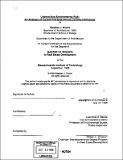Underwriting environmental risk : an analysis of current practices among lending institutions
Author(s)
Russo, Stephan J. (Stephan Joseph), 1969-
DownloadFull printable version (5.293Mb)
Advisor
Lawrence S. Bacow.
Terms of use
Metadata
Show full item recordAbstract
The purpose of this thesis is to investigate how banks and other lending institutions approach environmental risk management -- how they evaluate, screen and provide for environmental risks in loan structuring and documenting loans. The intent of this investigation is to identify and assess differences in lending policies, practices, and pricing techniques among various lending institutions. This thesis will also examine how, via their lending policies and practices, lenders can encourage sustainable development, brownfield redevelopment, and ecologically responsible technologies in property development. This thesis proposes that there are three fundamental types of environmental risk. The first type is the actual or perceived contamination of the property that directly impairs the underlying asset value. This is the most easily understood type of environmental risk and can be assessed during the due diligence period before the transaction of the property. After contamination, the second risk affecting collateral value may occur from subsequent restrictions on property use, or in the processes or materials employed by the business operating on the property. The Environmental Protection Agency (EPA) can impose deed or other restrictions on the use of a property because of potential environmental contamination or other environmental hazards. Such limitations against the "highest and best use" could substantially diminish the potential revenue of a property and consequentially commercial property values. In this scenario, the real asset is unaffected, but a company's credit worthiness may suffer. The third type of environmental risk to a business is a possible change in consumer preferences or demands for eco-friendly products. In an extreme case, consumers could boycott environmentally damaging products, or possibly the firms that manufacture them. Again, losses in revenue may constrain a company's ability to satisfy loan payments. This thesis seeks to investigate how the three forms of environmental risk are factored into loan pricing and how banks evaluate information regarding environmental policies and consumer demands when determining corporate revenues and property values. In addition, the paper will study some of the lending institutions' due diligence and loan evaluation procedures when assessing these environmental risks.
Description
Thesis (S.M.)--Massachusetts Institute of Technology, Dept. of Architecture, 1998. Includes bibliographical references (leaves 64-68).
Date issued
1998Department
Massachusetts Institute of Technology. Department of ArchitecturePublisher
Massachusetts Institute of Technology
Keywords
Architecture